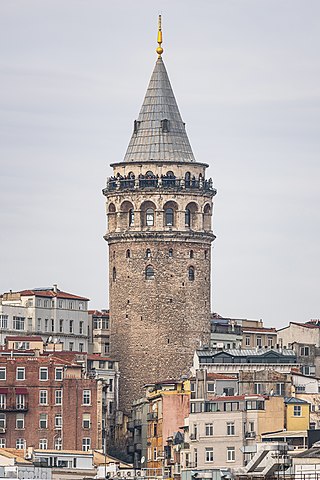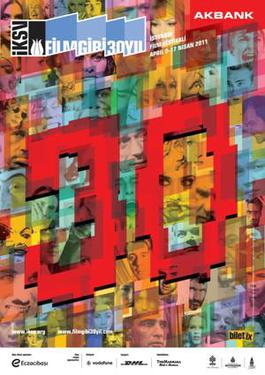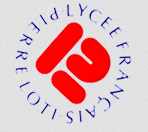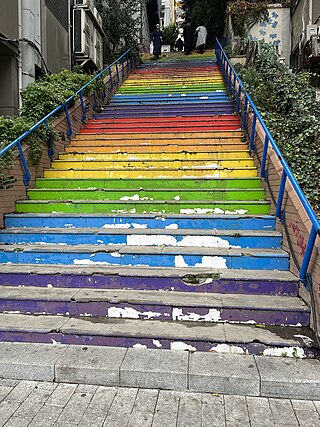
The Galata Tower, officially the Galata Tower Museum, is an old Genoese tower in the Galata part of the Beyoğlu district of Istanbul, Turkey. Built as a watchtower at the highest point of the (lost) Walls of Galata, the tower is now an exhibition space and museum, and a symbol of Beyoğlu and Istanbul.

The Latin Church of the Catholic Church has several dispersed populations of members in the Middle East, notably in Turkey, Cyprus and the Levant. Latin Catholics employ the Latin liturgical rites, in contrast to Eastern Catholics who fall under their respective church's patriarchs and employ distinct Eastern Catholic liturgies, while being in full communion with the worldwide Catholic Church. Latin Catholics in the Middle East are often of European descent, particularly from the medieval Crusader era and later the 20th-century colonial period.

Galata is the former name of the Karaköy neighbourhood in Istanbul, which is located at the northern shore of the Golden Horn. The district is connected to the historic Fatih district by several bridges that cross the Golden Horn, most notably the Galata Bridge. The medieval citadel of Galata was a colony of the Republic of Genoa between 1273 and 1453. The famous Galata Tower was built by the Genoese in 1348 at the northernmost and highest point of the citadel. Galata is now a quarter within the district of Beyoğlu in Istanbul.

The Basilica Cistern, or Cisterna Basilica, is the largest of several hundred ancient cisterns that lie beneath the city of Istanbul, Turkey. The cistern, located 150 metres (490 ft) southwest of the Hagia Sophia on the historical peninsula of Sarayburnu, was built in the 6th century during the reign of Byzantine emperor Justinian I. Today it is kept with little water, for public access inside the space.

Beyoğlu is a municipality and district of Istanbul Province, Turkey. Its area is 9 km2, and its population is 225,920 (2022). It is on the European side of Istanbul, Turkey, separated from the old city by the Golden Horn. It was known as the region of Pera surrounding the ancient coastal town Galata which faced Constantinople across the Horn. Beyoğlu continued to be named Pera during the Middle Ages and, in western languages, into the early 20th century.

The Camondo family was a prominent Jewish family of financiers and philanthropists who were active in Europe and the Ottoman Empire.

Karaköy, the modern name for the old Galata, is a commercial quarter in the Beyoğlu district of Istanbul, Turkey, located at the northern part of the Golden Horn mouth on the European side of Bosphorus.

Jewish Museum of Turkey is a cultural center established by the Quincentennial Foundation to inform the society of the traditions and history of Turkish Jewry. It was inaugurated on November 25, 2001. The Quincentennial Foundation was established in 1989 by 113 Turkish citizens, Jews and Muslims alike, to celebrate the five hundredth anniversary of the arrival of Sephardim to the Ottoman Empire. The idea of a museum was proposed by Naim Güleryüz who is now its curator and the foundation was financed by the prominent Jewish Kamhi family.

Religion in Istanbul covers the issue of religion in the city of Istanbul, Turkey. More than 90% of Istanbul's population are Sunni Muslims and Alevism forms the second biggest religious group. A 2019 survey study by KONDA that examined the religiosity of the voting-age adults in Istanbul showed that 47% of the surveyed had a religion and were trying to practise its requirements. This was followed by nonobservant people with 34% who identified with a religion but generally did not practise its requirements. 11% stated they were fully devoted to their religion, meanwhile 4% were non-believers who did not believe the rules and requirements of a religion and 4% were atheists who did not believe in religion at all. 24% of the surveyed also identified themselves as "religious conservatives".

Bankalar Caddesi, also known as Voyvoda Caddesi, in the historic Galata quarter of the district of Beyoğlu (Pera) in Istanbul, Turkey, was the financial centre of the late Ottoman Empire. It strikes out west from busy Kemeraltı Caddesi in Karaköy and segues into Okçu Musa Caddesi which leads up to Şişhane and Tepebaşı in Beyoğlu.

The Molla Çelebi Mosque, sometimes known as the Fındıklı Mosque is a 16th-century Ottoman mosque located in the Fındıklı neighbourhood of the Beyoğlu district of Istanbul, Turkey. It was commissioned by Kazasker Mehmet Vusuli Efendi, chief judge of Istanbul and designed by the imperial architect Mimar Sinan. The mosque is located on the Bosphorus waterfront, close to the Kabataş ferry port and Dolmabahçe Mosque.

The 30th International Istanbul Film Festival was a film festival held in Istanbul, Turkey, which ran from April 2 to 17, 2011. 232 films were screened in 21 categories at Atlas, Beyoğlu, Fitaş, Pera Museum Cinema, Nişantaşı CityLife, and Kadıköy Rexx.

Kasımpaşa is a working-class neighbourhood on the northern shore of the Golden Horn within the Beyoğlu district of Istanbul, Turkey, on the European side of the city. Once best known for its naval bases and shipyards, it is a rapidly evolving area, likely to be greatly changed by the Haliçport-Tersane Istanbul projects taking shape along its shoreline in 2022.

Istanbul Modern, a.k.a. Istanbul Museum of Modern Art, is a contemporary art gallery located inside the Galataport complex in the Beyoğlu district of Istanbul, Turkey. Inaugurated on December 11, 2004, Istanbul Modern was Turkey's first modern and contemporary art gallery and focuses on Turkish artists. It is a private venture under the umbrella of the nonprofit Istanbul Foundation for Culture and Arts.
Private Armenian School of Pangaltı is a private Armenian community school in Pangaltı quarter in Şişli district, Istanbul, Turkey.

Lycée Français Pierre Loti d'Istanbul is an international French school located in Istanbul. It was formerly known as "Papillon" and later took its name from the French writer Pierre Loti, who lived in Istanbul for a period of time. The school provides education from preschool to the final year of high school. It has two campuses, one in Tarabya and the other in Beyoğlu. In the late 1990s and early 2000s, due to the earthquake risk associated with the building in Beyoğlu, the middle school and high school were relocated to Tarabya, while continuing their educational activities. The preschool and primary school, however, remained in Beyoğlu.

Kuledibi is a quarter of İstanbul's Beyoğlu district. The term is generally used to describe the surrounding areas around the Galata Tower. The region extends to the streets parallel to Voyvoda Street in the south, Okçu Musa Street in the west, Yüksek Kaldırım Street in the east, Tımarcı Street and Şahkulu Street in the north.

The Genoese Palace, alternatively known as the Palace of the Podestà, is a medieval palace in Galata, which was a colony of the Republic of Genoa between 1273 and 1453.

Istanbul is generally tolerant of LGBT people, at least compared to elsewhere in Turkey.

The "rainbow stairs" refer to a rainbow-painted staircase in Beyoğlu, in Istanbul, Turkey.



















